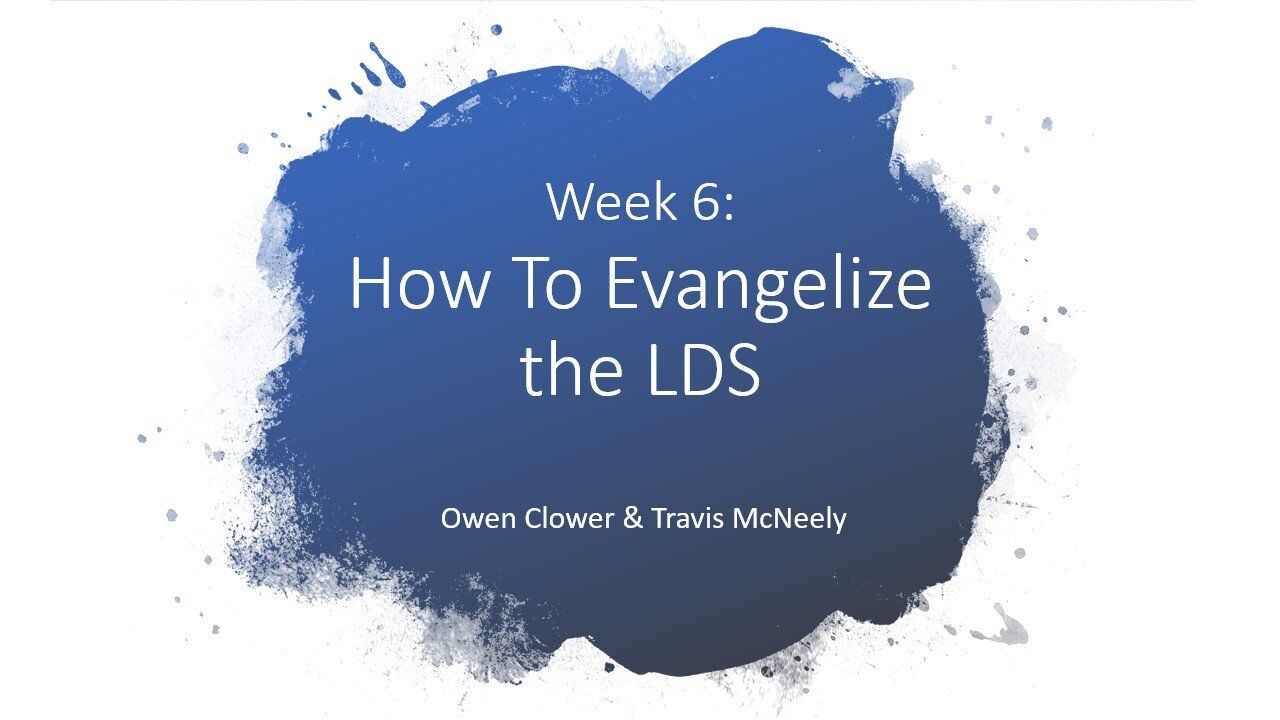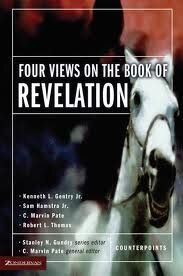Book Review: Four Views on the Book of Revelation


Introduction
There have been many views on the Apocalypse of John throughout church history. Considering modern responses to it, on the one hand, Revelation has had the obsessive type, which restlessly points out every major event as somehow connected to the Last Days (9). And on the other hand, there are those who would quip that this book is irrelevant and see the modern-day paranoia as foolishness (9). Most Christians today find themselves between these two extremes and this book out of Zondervan’s Counterpoint Series presents to its readers four different views on the book of Revelation: the preterist, the idealist, and the futurist: which branches out into two other views, both the progressive and classical dispensationalists (10). The aim of this book is to take four different authors each representing their own views, under the editors, Stanley N. Gundry and C. Marvin Pate, and present why their view is correct in light of the differing views mentioned in the book. When it comes to understanding the summary below, one must take into account the role the study of hermeneutics plays in interpreting this perplexing book of the Bible. Each author claims they hold to the grammatical-historical interpretation of Revelation, which may in fact be the case, but obviously, each disagrees with the other. Why is this the case? Because from this method of interpretation, authors may seek an additional facet to their interpretation: either literal, symbolic, futurist or a mix of these. One must also consider the resources each author appeals to, so that they may prove their point. Also how each author takes the date of this book’s writing is key to their interpretation as will be seen. Much can be written concerning each interpretation of Revelation, but in this summary there will be portions of what sets each view apart from the other.
Summary
Every view presented gives an outline of Revelation from start to finish, from the prologue, to the throne room scene, the trumpet and bowl judgments, the sections on the Beast and the false prophet, the coming of Christ, and the new heavens and the new earth. Each have sections where they give more focus than others, and have subsections to go into further detail to prove their views. Followed by a conclusion, each takes a small amount of time to give statements against the other views. At the core of every view is this interpretative key question: how do they interpret the introduction to Revelation?The first view encountered in this volume is the preterist view (36-92). It was written by Kenneth L. Gentry Jr. perhaps best known for his work, Before Jerusalem Fell. He is a postmillennialist, who has written extensively on eschatological issues and covenant theology. In presenting the preterist view of Revelation, he summarizes it saying, “The closer we get to the year 2000, the farther we get from the events of Revelation. This claim, as remarkable as it may sound, summarizes the evangelical preterist view of Revelation” (37). The preterist view interprets the book of Revelation to have been fulfilled in the first century under emperor Nero, and the destruction of the Temple at Jerusalem. A key hermeneutical factor to this view is the dating of the book, which is believed to be from A.D. 54-68 during emperor Nero’s reign. In contrast to the futurist view who believe that it was written: A.D. 81-96 Domitian’s rule (14, 22). Why is that important? Well for preterists, they believe the language and figures of Revelation point to Nero as the beast (68-9).The preterist leans heavily on Josephus’ work The War of the Jews and other early church fathers, to make their case about the things happening in Revelation finding their fulfillment within the context of the first century A.D. (250). Believing, like the other views do as well, that the interpretative key is found in Revelation 1, preterists argue, “the events of Revelation ‘must soon [Gk. tachos] take place’ (v.1) because ‘the time is near [Gk. engys]’”(40-1). The temporal proximity of those words is how they build the argument that all this will take place in their lifetime, post-58 A.D. (41).The second view presented in this volume is the idealist view of Revelation. Sam Hamstra Jr., who espouses an amillennial view of the Apocalypse, argues for a “spiritual” or “symbolic” interpretation of the book (23). Therefore, those who hold this view believe that interpretation can subjective to one’s own view(s), because the symbols are “multivalent in meaning and without specific historical referent” (24). The idealist believes that as a symbolically interpreted book it can be used to make a plethora of applications to the lives of believers in the modern-day church. Hamstra does not state that he is purely idealistic, which is important to not completely dismiss this view (127). For instance, idealists believe that the second coming of Christ is a reality and is a prediction in the book of Revelation (128). So there is a hint of futurism there, but pure idealists would shy away from that interpretation of Revelation still.On page 129, point three, there is probably the best and shortest summation to the idealist view in this whole work, but is unfortunately to long for this preview. For encouragement to further research that quote, Hamstra states that, “The heart and soul of the idealist approach is that Revelation is an apocalyptic book that presents spiritual precepts through symbols,” This is the beginning of an excellent summary on the entire view, to have a good grasp on it’s perspective, read that paragraph.The third view presented in this volume is that of Progressive Dispensationalism, which holds to the dichotomy of the “already/not yet” eschatological tension (31). This is proposed to be evident throughout Scripture (31-4) and is done so by Marvin Pate, the general editor of this volume and a prolific writer on a variety of subjects in the realm of Christianity. To the Progressive, this is true of Revelation and thus the entire New Testament. This view holds to a mix of genres of evident in the text: an apocalypse, a letter, and prophetic (135). Three specific summarized statements out of the “already/not yet” eschatology, will help to understand Progressive Dispensationalism (175). The first is the distinction between Israel and the church, that the Gentiles, by faith in Jesus Christ, are already one people of God. The second is that the premillennial position is held, meaning that the kingdom of God has begun in heaven, but it has not appeared on earth yet. The third was that while there may be some “messianic woes” during the first generation of Christians, the Great Tribulation has yet to come.The fourth and final view argued was Classical Dispensationalism, expounded upon by Robert Thomas, a staunch debater and proponent of this school of eschatology. One unique thing about Thomas, which was not as evident in the other authors, was that he focused major portions of his limited writing space to hermeneutics (180-5). He argued persuasively and took time to show why the other views had weaker methods of interpretation, some comments were very scathing of the preterist viewpoint (183, 191, 209, 213). He also gives other critiques as well to the idealist and the progressive dispensationalist views, but not as scathing as the preterist view. Part of what makes Classical different from Progressive is that Progressive tends to take a both a symbolic and literal approach to interpreting the text, whereas the Classical is completely literal in its interpretation (209). Thomas believes they err in regards to their understanding of the Davidic covenant and in regards to symbolizing Babylon (183-5, 201-4). This strays from the grammatical-historical approach in hermeneutics and should therefore be shunned according to Thomas (212).
Evaluation
The volume did very good at presenting each view equally. The authors expressed their views clearly and articulately. They all had the same amount of space to argue for their views and each were persuasive in their style. Unfortunately a major weakness to this work is the lack of debate. There was just a few subtle jabs or short explanations about a paragraph long on why the other views were incorrect. Therefore, the two greatest critiques to this book would be; first of all, the fact that this book was not called Five Views of Revelation because of a historically important view titled, historic premillennial eschatology. There is no mention of it whatsoever, which is quite a shame since it still has some adherers today and also since it played a huge role in the history of the church’s interpretation of Revelation.My second critique to this volume would have to be the lack of real debate between the different views. Obviously there were moments when authors would explain why one view made an error in a particular text, and also at the end of each conclusion was a brief paragraph per opposing view to state why they were incorrect. But truly that is not enough for a book of this magnitude. What would have been better would be a chance for each author to respond to exactly what was critiqued about their view, i.e., a counter, so that the readers can see whether or not the proponent of a view could give a sufficient rebuttal to the accusations. It made it very difficult intellectually because many of the arguments were convincing with the evidence stated, but when another section was read it would add to the confusion when a critique was made. As I read, I kept asking, “But what would the proponent of (enter view here) say in response to that accusation?” There needs to be an added rebuttal section to this work. The classical dispensationalist handled the subject of hermeneutics well in explaining what exactly hermeneutics is in relation to this heated topic (211, 224-9). It was very helpful and the most persuasive view in the volume. This book overall was a somewhat confusing and yet clarifying book to read.
Significance and Usefulness
This volume was very helpful through being introduced to many authors and resources regarding the various interpretations of Revelation. This book is useful for teaching someone or a small group about the various interpretations in the church throughout its history. But also of the dangers of misinterpreting this book can be costly to one’s handling of crucial ideas in Scripture that are commanded to all believers. Also, it is not only very useful, but it is very significant because, there are many books that deal with either one or two of these views at a time in a deep, thorough, outline fashion. Although not many or maybe not any at all have four of the major views explained in one volume.
Points of Interest
1.) On page 40, Plato said, “The beginning is the most important part of the work.” And that has proven true in the study of Revelation. In many excerpts from this book, the interpretation of chapter 1 has played a huge part in distinguishing between the three major views: preterist, idealist, futurist.
2.) On pages 51-2, I never knew God threatened Israel with divorce. It really caught me off guard, especially with regard to Jesus’ teaching on divorce in the New Testament. This has piqued my interest in studying that subject in the Old Testament.
3.) On page 86, The preterist is like the idealist in regards to symbolic imagery in the last chapters of revelation. This brought shock the most when the author said that based on Scripture the new creation began in the first century.
4.) On pages 95-98, the word “you” is used 54 times, in the intro to idealist view, in reference to the application-driven hermeneutics, which is reminiscent of post-modernism.
5.) On page 168, this particular critique of the preterist view from progressive dispensationalists really made me want to look further into the technicalities of the critique.
6.) On page 172, The six Paradisal blessings of Christ in the eternal state were extremely encouraging to read and made me very excited about heaven and my relationship with God now.
7.) On page 191, Classical Dispensationalism has a hard critique against Preterist’s, with Scripture references, in which they pointed out where Jesus taught against trying to predict the time of his return.
8.) On page 228, the nearness and imminence of Christ’s return is highlighted with a load of Scripture references that totally tear down the preterist system.
Conclusion
Overall, this volume is a great tool to put into the hands of pastors and lay-persons who are interested in studying the book of Revelation, and may not have a solid understanding of the hermeneutical history that surrounds this much-disputed text. By doing so, it will be of great benefit to any reader of the Scriptures to see how-to and how-not-to interpret the Apocalypse. This work is highly recommended, not just to read once, but to read, again and again, to be able to interpret one’s own eschatological views in light of Scripture.
Want To Book Me for Your Event or Conference?
Fill out the form below and we'll be in touch!
Book Travis McNeely
We will get back to you as soon as possible
Please try again later
More posts like this...





